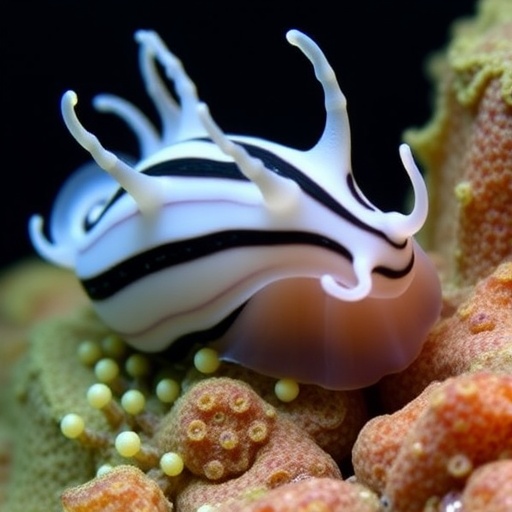In a remarkable study that delves deep into the dynamics of marine ecology, researchers Dror, Lotan, and Angel have made groundbreaking discoveries surrounding the interactions between scyphozoan polyps and alien aeolid nudibranchs. Published in the forthcoming issue of Front Zool, this research spotlights the often overlooked yet critical aspects of marine life predation and the complex relationships within marine ecosystems. The findings highlight how predation plays an intriguing role in transferring genetic traits and defensive strategies among marine invertebrates.
The alien aeolid nudibranch, a strikingly beautiful mollusc, has taken the world of marine biology by storm. These creatures are known for their vibrant colors and intricate morphology, but their ecological role is what’s truly compelling. The research demonstrates how these nudibranchs actively predate on scyphozoan polyps, which constitute a key phase in the life cycle of jellyfish. The relationship between predators and their prey is fundamental to understanding marine biodiversity and the intricate webs of interactions that sustain ocean ecosystems.
One of the most groundbreaking aspects of the study lies in the selective incorporation of hydrozoan nematocysts by the nudibranchs. Nematocysts are specialized stinging cells found in certain marine organisms, particularly within the cnidarians. The researchers revealed that the nudibranchs possess the remarkable ability to selectively incorporate these stinging cells from their prey, which they can then utilize for their own defense. This transfer not only provides these nudibranchs with a form of protection from potential predators but introduces a fascinating twist to the ecological narrative at play in their habitats.
Through meticulous observation and controlled laboratory experiments, Dror and colleagues documented the feeding behaviors of these nudibranchs, shedding light on their predatory strategies. They found that nudibranchs exhibited preferences for specific polyps, showing a clear understanding of their nutritional value and the potential defensive benefits conferred by the acquired nematocysts. This research opens up new avenues in understanding food webs, offering insights into how prey species evolve in response to predation pressures and how they might further adapt to survive in their changing environments.
Moreover, the study highlights the role of predation in shaping ecological interactions, emphasizing how these nudibranchs impact the population dynamics of scyphozoan polyps. The researchers found that by preying on these polyps, the nudibranchs could regulate their populations, potentially preventing overabundance that might lead to harmful blooms. This implicates nudibranchs not just as passive residents of their ecosystems but as active participants in ecological processes, possessing the ability to maintain a balance among marine species.
The findings also suggest broader implications for marine conservation efforts. Understanding these intricate predator-prey relationships aids in predicting how disruptions to marine ecosystems—whether through climate change or human activity—could impact these critical interactions. As saviors to the ocean’s health, these nudibranchs could serve as bioindicators, illuminating the health of their environments and the overall resilience of marine ecosystems in response to external stresses.
The fascinating dynamics of this predation extend beyond basic feeding behaviors. The ability of nudibranchs to utilize acquired nematocysts from their prey can be seen as a model for exploring evolutionary biology. This behavior may provide clues to how certain species adapt not just to threats but also to exploit available resources in innovative ways. The evolutionary ramifications of incorporating another organism’s lethal weapon are profound, influencing various aspects of survival and reproductive success within diverse marine communities.
As marine ecosystems face increasing pressures stemming from climate change and habitat destruction, studies like this one underscore the necessity of understanding interspecies interactions. Recognizing how specific predatory behaviors can lead to shifts in population dynamics prompts a reevaluation of conservation strategies that prioritize the protection of these unique species. Future research could delve into how such interactions vary under different environmental stressors, ultimately contributing to more effective marine conservation policies.
In summation, the research conducted by Dror, Lotan, and Angel has profound implications for our understanding of marine biology. Their insights illustrate the interconnected nature of marine life and highlight the delicate balance maintained within ecosystems. By uncovering how an alien species influences the dynamics of scyphozoan polyps through predation and selective incorporation of nematocysts, the study not only sheds light on the adaptability of marine organisms but also calls for heightened awareness and protection of these crucial underwater realms.
As the academic community eagerly anticipates the publication of this study, the myriad questions raised regarding predation, adaptation, and ecological dynamics promise to spur further inquiry. The implications stretch far beyond the immediate ecosystem and touch upon broader themes of biodiversity and conservation. Ultimately, it reinforces the idea that understanding the nuances of marine life can inform global strategies for preserving our oceans.
In conclusion, this study exemplifies the intricate connections that govern marine life and the importance of preserving these environments. The alien aeolid nudibranch stands as a testament to the wonders of evolutionary innovation, showcasing the extraordinary adaptations that even the smallest creatures can develop to survive and thrive in a constantly changing world. As marine biologists continue to unravel the mysteries of the ocean, discoveries like this will undoubtedly contribute to a deeper appreciation of the biodiversity that inhabits our blue planet.
Subject of Research: Predation on Scyphozoan Polyps and Selective Hydrozoan Nematocyst Incorporation Dynamics in Alien Aeolid Nudibranchs
Article Title: Predation on scyphozoan polyps and selective hydrozoan nematocyst incorporation dynamics in an alien aeolid nudibranch.
Article References:
Dror, H., Lotan, T. & Angel, D. Predation on scyphozoan polyps and selective hydrozoan nematocyst incorporation dynamics in an alien aeolid nudibranch.
Front Zool 22, 33 (2025). https://doi.org/10.1186/s12983-025-00589-9
Image Credits: AI Generated
DOI: https://doi.org/10.1186/s12983-025-00589-9
Keywords: Marine ecology, Alien aeolid nudibranch, Scyphozoan polyps, Hydrozoan nematocysts, Predator-prey dynamics, Biodiversity, Conservation, Evolutionary biology.
Tags: alien aeolid nudibranchsbiodiversity in ocean ecosystemscnidarian stinging cellsecological roles of nudibranchsFront Zool publicationjellyfish life cyclemarine ecology dynamicsmarine food websmarine invertebrate interactionsnematocyst incorporationpredation and genetic transferscyphozoan polyp predation





